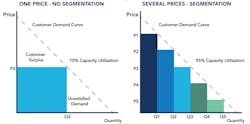In today’s data rich world, managers have little excuse to rely on “rules of thumb” except for habit and convenience; but these are surprisingly powerful forces. A history of success and survival creates confidence in rules of thumb, and often managers don’t recognize the fundamental changes that are occurring. Recognize your decision biases, and ensure decisions are based on data and facts with clear causal relationships to resources, operations, and economics. Let’s explore a few common “rules of thumb”.
Fixed and variable cost confusion: It is rare when making a decision that you care about fixed or variable costs; what you care about is which costs are and are not avoidable as a result of the decision. For example, you identify an improvement that cuts maintenance by 50% on a category of equipment. You have one technician doing that maintenance. That technician’s salary and benefits may be considered fixed or variable by your cost model. Does it matter? Realizing savings depends on how difficult such technicians are to hire, whether a qualified technician is willing to work part time, or whether you can move half the technician’s time to another task. Clearly the improvement should be implemented; it creates more up time and the potential for savings or redeployment of talent. Any cost must be examined more carefully than its characterization as fixed or variable to determine avoidability.
Profit as a percentage of sales: This is a typical measure to evaluate product attractiveness, and it is simply wrong. First, it fails to consider return on invested capital, your business infrastructure, and production capability. Second, it normally only looks at gross margin (sales price minus product cost), which overlooks selling and marketing costs and usually post-sale support and warranty costs.
Pursuing return on investment (ROI) the wrong way: ROI is a critical measure, but only when used responsibly. The goal behind ROI is to increase the return. Game playing executives pursuing poorly constructed performance bonuses at any cost often focus on minimizing the investment—a path to disaster and often the end of a manufacturer. In the U.S., capital markets have rewarded ROI improvement whether progress came from increasing the return or minimizing the investment with negative consequences for domestic manufacturing. Improving return should involve long-term thinking about items categorized as expenses for financial statements, but are really investments in the future, such as research and development, employee training, process improvement, and many data and information technology enhancements.
Overfocus on product cost: Creating operational improvements is essential, but product cost is not the only important cost information for a manufacturer—it is simply the most available. Customer costing can provide highly valuable insights. Customer behavior drives a wide variety of organizational costs. Frequency of orders, returns, changes, requests for customization, etc., all have a significant effect on manufacturing and warehousing costs. Beyond the factory, difficult or complicated customers consume management, sales, order processing, credit and collections, and customer service support time and effort. Many of these costs are not included in product cost or are allocated non-causally by an overhead driver. Most customer-driven costs are simply included in selling, general, and administrative expenses where they are poorly categorized and hidden from management analysis.
Manufacturing technology is dramatically improving with smart manufacturing technology, more powerful information technology, and rapidly improving data analytics. However, manufacturing management needs to examine much more than the factory to reap these benefits and improve their business. Re-examining traditional thinking about the management, administration, financing, and support is also vital, and failure to do so may thwart other hard-earned competitive advantages.
Larry White, CMA, CFM, CPA, CGFM, [email protected], is Executive Director of the Resource Consumption Accounting Institute (www.rcainstitute.org) which trains and advocates for improved cost information connecting operations to business performance.
About the Author

Leaders relevant to this article:

